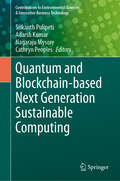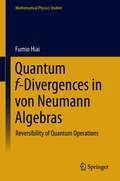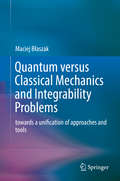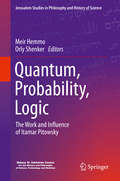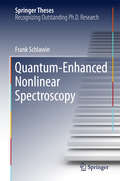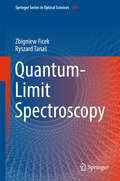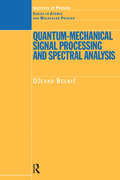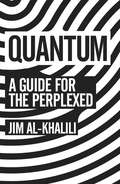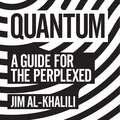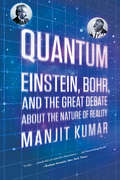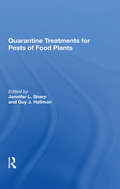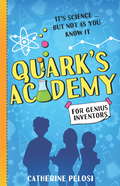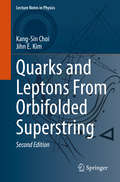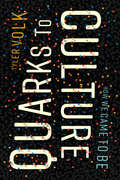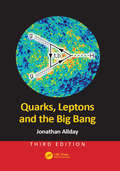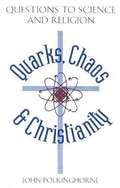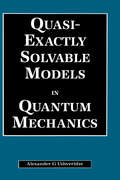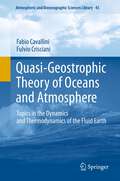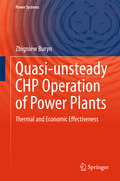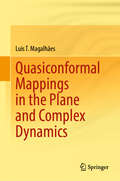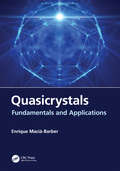- Table View
- List View
Quantum and Blockchain-based Next Generation Sustainable Computing (Contributions to Environmental Sciences & Innovative Business Technology)
by Adarsh Kumar Cathryn Peoples Srikanth Pulipeti Nagaraju MysoreQuantum and Blockchain technology innovations have recently gained a lot of attention and have been integrated with other contemporary technologies for numerous applications. As a result, these applications achieve sustainability, robustness, scalability, security, accountability, and efficiency. Thus, this book covers the principles, terminologies, methods, protocols, and sustainability of quantum and blockchain technology. Furthermore, it provides insights into numerous challenges associated with other domains of computer science. In addition, the book provides various opportunities to integrate the quantum and blockchain technology-based sustainable solutions that incorporate low-cost, quality of services, secure and faster delivery of services for future demands in the fields such as cryptography, artificial intelligence (AI), machine learning (ML), deep learning (DL), computer vision, healthcare, autonomous vehicles, transportation, information, and communication theory. The information in this book is extremely useful for readers and practitioners in different fields including chemistry, mechanical and automotive engineering, healthcare, computer science, data science, and business analysis specialists in combining both basic and advanced level principles.
Quantum f-Divergences in von Neumann Algebras: Reversibility of Quantum Operations (Mathematical Physics Studies)
by Fumio HiaiRelative entropy has played a significant role in various fields of mathematics and physics as the quantum version of the Kullback–Leibler divergence in classical theory. Many variations of relative entropy have been introduced so far with applications to quantum information and related subjects. Typical examples are three different classes, called the standard, the maximal, and the measured f-divergences, all of which are defined in terms of (operator) convex functions f on (0,∞) and have respective mathematical and information theoretical backgrounds. The α-Rényi relative entropy and its new version called the sandwiched α-Rényi relative entropy have also been useful in recent developments of quantum information.In the first half of this monograph, the different types of quantum f-divergences and the Rényi-type divergences mentioned above in the general von Neumann algebra setting are presented for study. While quantum information has been developing mostly in the finite-dimensional setting, it is widely believed that von Neumann algebras provide the most suitable framework in studying quantum information and related subjects. Thus, the advance of quantum divergences in von Neumann algebras will be beneficial for further development of quantum information. Quantum divergences are functions of two states (or more generally, two positive linear functionals) on a quantum system and measure the difference between the two states. They are often utilized to address such problems as state discrimination, error correction, and reversibility of quantum operations. In the second half of the monograph, the reversibility/sufficiency theory for quantum operations (quantum channels) between von Neumann algebras via quantum f-divergences is explained, thus extending and strengthening Petz' previous work.For the convenience of the reader, an appendix including concise accounts of von Neumann algebras is provided.
Quantum optics
by Marlan O. Scully M. Suhail ZubairyThe field of quantum optics has witnessed significant theoretical and experimental developments in recent years. This book provides an in-depth and wide-ranging introduction to the subject, emphasising throughout the basic principles and their applications. The book begins by developing the basic tools of quantum optics, and goes on to show the application of these tools in a variety of quantum optical systems, including lasing without inversion, squeezed states and atom optics. The final four chapters are devoted to a discussion of quantum optical tests of the foundations of quantum mechanics, and to particular aspects of measurement theory. Assuming only a background of standard quantum mechanics and electromagnetic theory, and containing many problems and references, this book will be invaluable to graduate students of quantum optics, as well as to researchers in this field.
Quantum versus Classical Mechanics and Integrability Problems: towards a unification of approaches and tools
by Maciej BłaszakThis accessible monograph introduces physicists to the general relation between classical and quantum mechanics based on the mathematical idea of deformation quantization and describes an original approach to the theory of quantum integrable systems developed by the author.The first goal of the book is to develop of a common, coordinate free formulation of classical and quantum Hamiltonian mechanics, framed in common mathematical language.In particular, a coordinate free model of quantum Hamiltonian systems in Riemannian spaces is formulated, based on the mathematical idea of deformation quantization, as a complete physical theory with an appropriate mathematical accuracy.The second goal is to develop of a theory which allows for a deeper understanding of classical and quantum integrability. For this reason the modern separability theory on both classical and quantum level is presented. In particular, the book presents a modern geometric separability theory, based on bi-Poissonian and bi-presymplectic representations of finite dimensional Liouville integrable systems and their admissible separable quantizations.The book contains also a generalized theory of classical Stäckel transforms and the discussion of the concept of quantum trajectories.In order to make the text consistent and self-contained, the book starts with a compact overview of mathematical tools necessary for understanding the remaining part of the book. However, because the book is dedicated mainly to physicists, despite its mathematical nature, it refrains from highlighting definitions, theorems or lemmas.Nevertheless, all statements presented are either proved or the reader is referred to the literature where the proof is available.
Quantum, Probability, Logic: The Work and Influence of Itamar Pitowsky (Jerusalem Studies in Philosophy and History of Science)
by Meir Hemmo Orly ShenkerThis volume provides a broad perspective on the state of the art in the philosophy and conceptual foundations of quantum mechanics. Its essays take their starting point in the work and influence of Itamar Pitowsky, who has greatly influenced our understanding of what is characteristically non-classical about quantum probabilities and quantum logic, and this serves as a vantage point from which they reflect on key ongoing debates in the field. Readers will find a definitive and multi-faceted description of the major open questions in the foundations of quantum mechanics today, including: Is quantum mechanics a new theory of (contextual) probability? Should the quantum state be interpreted objectively or subjectively? How should probability be understood in the Everett interpretation of quantum mechanics? What are the limits of the physical implementation of computation? The impact of this volume goes beyond the exposition of Pitowsky’s influence: it provides a unique collection of essays by leading thinkers containing profound reflections on the field.Chapter 1. Classical logic, classical probability, and quantum mechanics (Samson Abramsky) Chapter 2. Why Scientific Realists Should Reject the Second Dogma of Quantum Mechanic (Valia Allori) Chapter 3. Unscrambling Subjective and Epistemic Probabilities (Guido Bacciagaluppi) Chapter 4. Wigner’s Friend as a Rational Agent (Veronika Baumann, Časlav Brukner) Chapter 5. Pitowsky's Epistemic Interpretation of Quantum Mechanics and the PBR Theorem (Yemima Ben-Menahem) Chapter 6. On the Mathematical Constitution and Explanation of Physical Facts (Joseph Berkovitz) Chapter 7. Everettian probabilities, the Deutsch-Wallace theorem and the Principal Principle (Harvey R. Brown, Gal Ben Porath) Chapter 8. ‘Two Dogmas’ Redu (Jeffrey Bub) Chapter 9. Physical Computability Theses (B. Jack Copeland, Oron Shagrir) Chapter 10. Agents in Healey’s Pragmatist Quantum Theory: A Comparison with Pitowsky’s Approach to Quantum Mechanics (Mauro Dorato) Chapter 11. Quantum Mechanics As a Theory of Observables and States and, Thereby, As a Theory of Probability (John Earman, Laura Ruetsche) Chapter 12. The Measurement Problem and two Dogmas about Quantum Mechanic (Laura Felline) Chapter 13. There Is More Than One Way to Skin a Cat: Quantum Information Principles In a Finite World(Amit Hagar) Chapter 14. Is Quantum Mechanics a New Theory of Probability? (Richard Healey) Chapter 15. Quantum Mechanics as a Theory of Probability (Meir Hemmo, Orly Shenker) Chapter 16. On the Three Types of Bell's Inequalities (Gábor Hofer-Szabó) Chapter 17. On the Descriptive Power of Probability Logic (Ehud Hrushovski) Chapter 18. The Argument against Quantum Computers (Gil Kalai) Chapter 19. Why a Relativistic Quantum Mechanical World Must be Indeterministic (Avi Levy, Meir Hemmo) Chapter 20. Subjectivists about Quantum Probabilities Should be Realists about Quantum States (Wayne C. Myrvold) Chapter 21. The Relativistic Einstein-Podolsky-Rosen Argument (Michael Redhead) Chapter 22. What price statistical independence? How Einstein missed the photon.(Simon Saunders) Chapter 23. How (Maximally) Contextual is Quantum Mechanics? (Andrew W. Simmons) Chapter 24. Roots and (Re)Sources of Value (In)Definiteness Versus Contextuality (Karl Svozil) Chapter 25: Schrödinger’s Reaction to the EPR Paper (Jos Uffink) Chapter 26. Derivations of the Born Rule (Lev Vaidman) Chapter 27. Dynamical States and the Conventionality of (Non-) Classicality (Alexander Wilce).
Quantum-Enhanced Nonlinear Spectroscopy
by Frank SchlawinThis thesis focuses on nonlinear spectroscopy from a quantum optics perspective. First, it provides a detailed introduction to nonlinear optical signals; starting from Glauber s photon counting formalism, it establishes the diagrammatic formulation, which forms the backbone of nonlinear molecular spectroscopy. The main body of the thesis investigates the impact of quantum correlations in entangled photon states on two-photon transitions, with a particular focus on the time-energy uncertainty, which restricts the possible simultaneous time and frequency resolution in measurements. It found that this can be violated with entangled light for individual transitions. The thesis then presents simulations of possible experimental setups that could exploit this quantum advantage. The final chapter is devoted to an application of the rapidly growing field of multidimensional spectroscopy to trapped ion chains, where it is employed to investigate nonequilibrium properties in quantum simulations. "
Quantum-Limit Spectroscopy
by Zbigniew Ficek Ryszard TanaśThis book covers the main ideas, methods, recent developments and applications of quantum-limit optical spectroscopy to quantum information, resolution spectroscopy, measurements beyond quantum limits, measurement of decoherence and entanglement. Quantum-limit spectroscopy lies at the frontier of current experimental and theoretical techniques, and is one of the areas of atomic spectroscopy where the quantization of the field is essential to predict and interpret the existing experimental results. Currently, there is an increasing interest in quantum and precision spectroscopy both theoretically and experimentally, due to a significant progress in trapping and cooling of single atoms and ions. This progress allows to explore in the most intimate detail the ways in which light interacts with atoms and to measure spectral properties and quantum effects with a large precision. Moreover, it allows to perform subtle tests of quantum mechanics on the single atom and single photon scale which were hardly even imaginable as ``thought experiments'' a few years ago.
Quantum-Mechanical Signal Processing and Spectral Analysis (Series in Atomic Molecular Physics)
by Dzevad BelkicQuantum-Mechanical Signal Processing and Spectral Analysis describes the novel application of quantum mechanical methods to signal processing across a range of interdisciplinary research fields. Conventionally, signal processing is viewed as an engineering discipline with its own specific scope, methods, concerns and priorities, not usually encompassing quantum mechanics. However, the dynamics of systems that generate time signals can be successfully described by the general principles and methods of quantum physics, especially within the Schroedinger framework. Most time signals that are measured experimentally are mathematically equivalent to quantum-mechanical auto-correlation functions built from the evolution operator and wavefunctions. This fact allows us to apply the rich conceptual strategies and mathematical apparatus of quantum mechanics to signal processing. Among the leading quantum-mechanical signal processing methods, this book emphasizes the role of Pade approximant and the Lanczos algorithm, highlighting the major benefits of their combination. These two methods are carefully incorporated within a unified framework of scattering and spectroscopy, developing an algorithmic power that can be exported to other disciplines. The novelty of the author's approach to key signal processing problems, the harmonic inversion and the moment problem, is in establishing the Pade approximant and Lanczos algorithm as entirely algerbraic spectral estimators. This is of paramount theoretical and practical importance, as now spectral analysis can be carried out from closed analytical expressions. This overrides the notorious mathematical ill-conditioning problems with round-off errors that plague inverse reconstructions in those fields that rely upon signal processing. Quantum-Mechanical Signal Processing and Spectral Analysis will be an invaluable resource for researchers involved in signal processing across a wide range of disciplines.
Quantum: A Guide For The Perplexed
by Jim Al-KhaliliFrom Schrodinger's cat to Heisenberg's uncertainty principle, this book untangles the weirdness of the quantum world.Quantum mechanics underpins modern science and provides us with a blueprint for reality itself. And yet it has been said that if you're not shocked by it, you don't understand it. But is quantum physics really so unknowable? Is reality really so strange? And just how can cats be half-alive and half-dead at the same time?Our journey into the quantum begins with nature's own conjuring trick, in which we discover that atoms -- contrary to the rules of everyday experience -- can exist in two locations at once. To understand this we travel back to the dawn of the twentieth century and witness the birth of quantum theory, which over the next one hundred years was to overthrow so many of our deeply held notions about the nature of our universe. Scientists and philosophers have been left grappling with its implications every since.
Quantum: A Guide For The Perplexed
by Jim Al-KhaliliFrom Schrodinger's cat to Heisenberg's uncertainty principle, this book untangles the weirdness of the quantum world.Quantum mechanics underpins modern science and provides us with a blueprint for reality itself. And yet it has been said that if you're not shocked by it, you don't understand it. But is quantum physics really so unknowable? Is reality really so strange? And just how can cats be half-alive and half-dead at the same time?Our journey into the quantum begins with nature's own conjuring trick, in which we discover that atoms -- contrary to the rules of everyday experience -- can exist in two locations at once. To understand this we travel back to the dawn of the twentieth century and witness the birth of quantum theory, which over the next one hundred years was to overthrow so many of our deeply held notions about the nature of our universe. Scientists and philosophers have been left grappling with its implications every since.Read by Hugh Kermode(p) 2016 Orion Publishing Group
Quantum: A Guide For The Perplexed (Mapping Science Ser.)
by Jim Al-KhaliliFrom Schrodinger's cat to Heisenberg's uncertainty principle, this book untangles the weirdness of the quantum world.Quantum mechanics underpins modern science and provides us with a blueprint for reality itself. And yet it has been said that if you're not shocked by it, you don't understand it. But is quantum physics really so unknowable? Is reality really so strange? And just how can cats be half-alive and half-dead at the same time?Our journey into the quantum begins with nature's own conjuring trick, in which we discover that atoms -- contrary to the rules of everyday experience -- can exist in two locations at once. To understand this we travel back to the dawn of the twentieth century and witness the birth of quantum theory, which over the next one hundred years was to overthrow so many of our deeply held notions about the nature of our universe. Scientists and philosophers have been left grappling with its implications every since.
Quantum: Einstein, Bohr, and the Great Debate about the Nature of Reality
by Manjit Kumar"A lucid account of quantum theory (and why you should care) combined with a gripping narrative."--San Francisco Chronicle Quantum theory is weird. As Niels Bohr said, if you weren't shocked by quantum theory, you didn't really understand it. For most people, quantum theory is synonymous with mysterious, impenetrable science. And in fact for many years it was equally baffling for scientists themselves. In this tour de force of science history, Manjit Kumar gives a dramatic and superbly written account of this fundamental scientific revolution, focusing on the central conflict between Einstein and Bohr over the nature of reality and the soul of science. This revelatory book takes a close look at the golden age of physics, the brilliant young minds at its core--and how an idea ignited the greatest intellectual debate of the twentieth century.
Quantum‐Enhanced Sensing Based on Time Reversal of Entangling Interactions (Springer Theses)
by Daniel LinnemannQuantum mechanics entails effects like superpositions and entanglement, which have no classical counterparts. From a technological standpoint these counterintuitive quantum aspects can be viewed as an unexploited resource that can be harnessed to support various tasks, e.g. in the domains of computation, communication, and metrology. In many applications, however, the potential of nonclassical states cannot practically be exploited due to detection inefficiencies. The authors address this limitation by experimentally realizing a novel detection scheme in which entangling interactions are time reversed. In this way, nonclassical many-particle states are disentangled, allowing them to be detected in a robust and technically feasible manner. In the context of quantum metrology, these nonlinear readout techniques extend the class of entangled probe states that can be leveraged for sensing applications without being limited by finite detector resolution. The authors present an active atom interferometer, where both the entangled state preparation and disentangling readout involve parametric amplification. This “SU(1,1)” interferometer is implemented with the help of spinor Bose–Einstein condensates, where amplification is implemented by atomic collisions leading to spin exchange.
Quarantine Treatments For Pests Of Food Plants
by Guy J Hallman Jennifer L SharpThis volume provides an overview of quarantine treatment for pests of food plants that involve heat, cold, irradiation, fumigants, modified atmospheres, and other techniques alone or in combination. The contributors discuss strategies for eliminating or reducing the need for post-harvest treatment by ensuring that commodities are free of all pests
Quark's Academy
by Catherine PelosiSCIENCE IN PROGRESS - ENTER AT YOUR OWN RISK!Junior science geniuses Augustine, Celeste and Oscar can't believe their luck when they're accepted into an elite and mysterious science academy summer camp run by the elusive Inventor Quark.From the moment they step inside the gates of Quark's Academy at the end of Molecule Drive, they know they're in for a week they'll never forget. But things at the academy are not quite what they seem, and the three quickly realise that they'll need to put their squabbles aside and their heads together if they're ever to get out of there alive...A page-turning adventure for readers aged eight to twelve, QUARK'S ACADEMY is bound to cause a hair-raising reaction!'an engaging and entertaining debut for readers aged eight and up with an interest in STEM - or those who just love a well-paced adventure story with fantastical elements.' 4.5 stars - BOOKS + PUBLISHING
Quarks and Leptons From Orbifolded Superstring (Lecture Notes in Physics #954)
by Kang-Sin Choi Jihn E. KimThis book offers a detailed guide on the journey towards the minimal supersymmetric standard model down the orbifold road. It takes the viewpoint that the chirality of matter fermions is an essential aspect that orbifold compactification allows to derive from higher-dimensional string theories in a straightforward manner. Halfway between textbook and tutorial review, the book is intended for the graduate student and particle phenomenologist wishing to get acquainted with this field.
Quarks to Culture: How We Came to Be
by Tyler VolkOur world is nested, both physically and socially, and at each level we find innovations that are necessary for the next. Consider: atoms combine to form molecules, molecules combine to form single-celled organisms; when people come together, they build societies. Physics has gone far in mapping the basic mechanics of the simplest things and the dynamics of the overall nesting, as have biology and the social sciences for their fields. But what can we say about this beautifully complex whole? How does one stage shape another, and what can we learn about human existence through understanding an enlarged field of creation and being?In Quarks to Culture, Tyler Volk answers these questions, revealing how a universal natural rhythm—building from smaller things into larger, more complex things—resulted in a grand sequence of twelve fundamental levels across the realms of physics, biology, and culture. He introduces the key concept of “combogenesis,” the building-up from combination and integration to produce new things with innovative relations. He explores common themes in how physics and chemistry led to biological evolution, and biological evolution to cultural evolution. Volk also provides insights into linkages across the sciences and fields of scholarship, and presents an exciting synthesis of ideas along a sequence of things and relations, from physical to living to cultural. The resulting inclusive natural philosophy brings clarity to our place in the world, offering a roadmap for those who seek to understand big history and wrestle with questions of how we came to be.
Quarks, Leptons and the Big Bang
by Jonathan AlldayCHOICE: Highly Recommended Quarks, Leptons and The Big Bang, Third Edition, is a clear, readable and self-contained introduction to particle physics and related areas of cosmology. It bridges the gap between non-technical popular accounts and textbooks for advanced students. The book concentrates on presenting the subject from the modern perspective of quarks, leptons and the forces between them. This book will appeal to students, teachers and general science readers interested in fundamental ideas of modern physics. This edition brings the book completely up to date by including advances in particle physics and cosmology, such as the discovery of the Higgs boson, the LIGO gravitational wave discovery and the WMAP and PLANCK results.
Quarks, chaos & Christianity: questions to science and religion
by John Polkinghorne"As someone who's both a scientist and an Anglican priest, I've been concerned with trying to understand how the scientific and religious views of the world relate to each other. Do we have to choose between them or are they, instead, complementary understandings that, seen together, give us a fuller picture than either on their own would provide? I find the best way to sort out what I really think is to try to write it down. The late Bishop John Robinson once said to me that he couldn't think without a pen in his hand, and I knew exactly what he meant. In consequence, I've written six books on different aspects of this question. Now I've decided it would be useful to try to provide an overview that surveyed the whole scene, rather than concentrating on this or that particular feature of it, as my earlier books have done. At the same time, it gives me the chance to try to set out the main lines of the argument without having to reproduce all the detailed discussion that I've gone into previously. I do a fair amount of speaking on these issues, and I always greatly enjoy the discussion period that normally follows a lecture. This experience has given me some idea of what the main questions are in people's minds, and what are the most helpful insights to offer them. I actually think that we need both science and religion, and that they have many important things to say to each other. I hope this short book may help others to share in such a conversation."
Quasi-Dimensional Simulation of Spark Ignition Engines: From Thermodynamic Optimization to Cyclic Variability
by Antonio Calvo Hernández Lev Guzmán-Vargas Asok K Sen Fernando Angulo-Brown Pedro Luis Curto-Risso Alejandro MedinaBased on the simulations developed in research groups over the past years, Introduction to Quasi-dimensional Simulation of Spark Ignition Engines provides a compilation of the main ingredients necessary to build up a quasi-dimensional computer simulation scheme. Quasi-dimensional computer simulation of spark ignition engines is a powerful but affordable tool which obtains realistic estimations of a wide variety of variables for a simulated engine keeping insight the basic physical and chemical processes involved in the real evolution of an automotive engine. With low computational costs, it can optimize the design and operation of spark ignition engines as well as it allows to analyze cycle-to-cycle fluctuations. Including details about the structure of a complete simulation scheme, information about what kind of information can be obtained, and comparisons of the simulation results with experiments, Introduction to Quasi-dimensional Simulation of Spark Ignition Engines offers a thorough guide of this technique. Advanced undergraduates and postgraduates as well as researchers in government and industry in all areas related to applied physics and mechanical and automotive engineering can apply these tools to simulate cyclic variability, potentially leading to new design and control alternatives for lowering emissions and expanding the actual operation limits of spark ignition engines
Quasi-Exactly Solvable Models in Quantum Mechanics
by A.G UshveridzeExactly solvable models, that is, models with explicitly and completely diagonalizable Hamiltonians are too few in number and insufficiently diverse to meet the requirements of modern quantum physics. Quasi-exactly solvable (QES) models (whose Hamiltonians admit an explicit diagonalization only for some limited segments of the spectrum) provide a practical way forward.Although QES models are a recent discovery, the results are already numerous. Collecting the results of QES models in a unified and accessible form, Quasi-Exactly Solvable Models in Quantum Mechanics provides an invaluable resource for physicists using quantum mechanics and applied mathematicians dealing with linear differential equations. By generalizing from one-dimensional QES models, the expert author constructs the general theory of QES problems in quantum mechanics. He describes the connections between QES models and completely integrable theories of magnetic chains, determines the spectra of QES Schrödinger equations using the Bethe-Iansatz solution of the Gaudin model, discusses hidden symmetry properties of QES Hamiltonians, and explains various Lie algebraic and analytic approaches to the problem of quasi-exact solubility in quantum mechanics.Because the applications of QES models are very wide, such as, for investigating non-perturbative phenomena or as a good approximation to exactly non-solvable problems, researchers in quantum mechanics-related fields cannot afford to be unaware of the possibilities of QES models.
Quasi-Geostrophic Theory of Oceans and Atmosphere
by Fabio Cavallini Fulvio CriscianiLarge-scale winds and currents tend to balance Coriolis and pressure gradient forces. The time evolution of these winds and currents is the subject of the quasi-geostrophic theory. Chapter 1 presents concepts and equations of classical inertial fluid mechanics. Chapter 2 deals with the equations of thermodynamics that close the governing equations of the fluids. Then, the motion is reformulated in a uniformly rotating reference frame. Chapter 3 deals with the shallow-water model and the homogeneous model of wind-driven circulation. The chapter also describes a classical application of the Ekman layer to the atmosphere. Chapter 4 considers the two-layer model, as an introduction to baroclinic flows, together with the concept of available potential energy. Chapter 5 takes into account continuously stratified flows in the ocean and in the atmosphere.
Quasi-unsteady CHP Operation of Power Plants
by Zbigniew BurynThis book analyzes the continuous operation of a power plant with condensing power units in combined heat and power mode (CHP-mode) over a period of one year. Focusing on the operation of one and two power-unit systems with differing heat exchanger configurations, this book uses mathematical modeling of the steam-water cycle of a 370 MW power unit to calculate the operating characteristics and mass-energy balance of the system. Featuring comprehensive thermodynamic analysis of the quasi-unsteady operation of power units in cogeneration for electrical power generation, as determined by the Polish Power System, this work also includes an economic analysis of the power plant, presenting the costs and economic effectiveness of such a system.
Quasiconformal Mappings in the Plane and Complex Dynamics
by Luis T. MagalhãesThis book comprehensively explores the foundations of quasiconformal mappings in the complex plane, especially in view of applications to complex dynamics. Besides playing a crucial role in dynamical systems these mappings have important applications in complex analysis, geometry, topology, potential theory and partial differential equations, functional analysis and calculus of variations, electrostatics and nonlinear elasticity . The work covers standard material suitable for a one-year graduate-level course and extends to more advanced topics, in an accessible way even for students in an initial phase of university studies who have learned the basics of complex analysis at the usual level of a rigorous first one-semester course on the subject. At the frontier of complex analysis with real analysis, quasiconformal mappings appeared in 1859-60 in the cartography work of A. Tissot, well before the term “quasiconformal” was coined by L. Ahlfors in 1935. The detailed study of these mappings began in 1928 by H. Grötzsch, and L. Ahlfors’ seminal work published in 1935 significantly contributed to their development and was considered for awarding him the Fields Medal in 1936. The theory further evolved in 1937 and 1939 with O. Teichmüller’s contributions, and subsequent advancements are partially covered in this book. Organized into ten chapters with eight appendices, this work aims to provide an accessible, self-contained approach to the subject and includes examples at various levels and extensive applications to holomorphic dynamics. Throughout the text, historical notes contextualize advancements over time. A sequel to the author’s previous book, ‘Complex Analysis and Dynamics in One Variable with Applications,’ also published by Springer, this volume might be suitable for students in mathematics, physics, or engineering. A solid background in basic mathematical analysis is recommended to fully benefit from its content.
Quasicrystals: Fundamentals and Applications
by Enrique Maciá-Barberpromoting the very notion of quasiperiodic order, and to spur its physical implications and technological capabilities. It, therefore, explores the fundamental aspects of intermetallic, photonic, and phononic quasicrystals, as well as soft-matter quasicrystals, including their intrinsic physical and structural properties. In addition, it thoroughly discusses experimental data and related theoretical approaches to explain them, extending the standard treatment given in most current solid state physics literature. It also explores exciting applications in new technological devices of quasiperiodically ordered systems, including multilayered quasiperiodic systems, along with 2D and 3D designs, whilst outlining new frontiers in quasicrystals research. This book can be used as a reader-friendly introductory text for graduate students, in addition to senior scientists and researchers coming from the fields of physics, chemistry, materials science, and engineering. Key features: • Provides an updated and detailed introduction to the interdisciplinary field of quasicrystals in a tutorial style, considering both fundamental aspects and additional freedom degrees provided by designs based on quasiperiodically ordered materials. • Includes 50 fully worked out exercises with detailed solutions, motivating, and illustrating the different concepts and notions to provide readers with further learning opportunities. • Presents a complete compendium of the current state of the art knowledge of quasicrystalline matter, and outlines future next generation materials based on quasiperiodically ordered designs for their potential use in useful technological devices. Dr. Enrique Maciá-Barber is Professor of condensed matter physics at the Universidad Complutense de Madrid. His research interests include the thermoelectric properties of quasicrystals and DNA biophysics. In 2010 he received the RSEF- BBVA Foundation Excellence Physics Teaching Award. His book Aperiodic Structures in Condensed Matter: Fundamentals and Applications (CRC Press, Boca-Raton, 2009) is one of the Top Selling Physics Books according to YBP Library Services.
